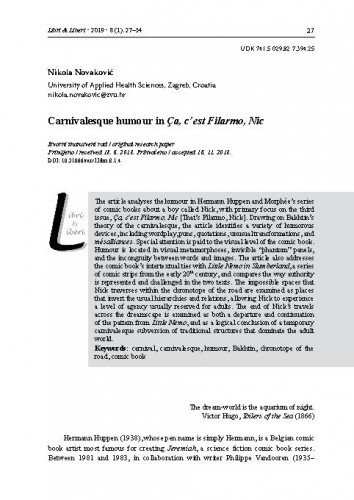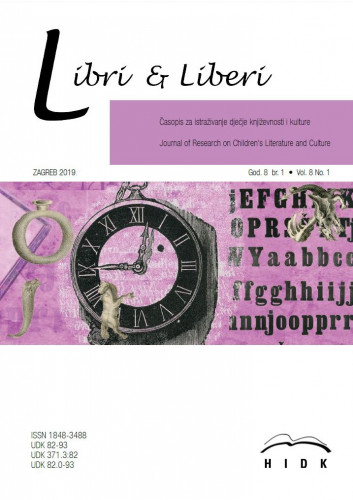The article analyses the humour in Hermann Huppen and Morphée’s series of comic books about a boy called Nick, with primary focus on the third issue, Ça, c’est Filarmo, Nic [That’s Filarmo, Nick]. Drawing on Bakhtin’s theory of the carnivalesque, the article identifies a variety of humorous devices, including wordplay, puns, quotations, unusual transformations, and mésalliances. Special attention is paid to the visual level of the comic book. Humour is located in visual metamorphoses, invisible “phantom” panels, and the incongruity between words and images. The article also addresses the comic book’s intertextual ties with Little Nemo in Slumberland, a series of comic strips from the early 20th century, and compares the way authority is represented and challenged in the two texts. The impossible spaces that Nick traverses within the chronotope of the road are examined as places that invert the usual hierarchies and relations, allowing Nick to experience a level of agency usually reserved for adults. The end of Nick’s travels across the dreamscape is examined as both a departure and continuation of the pattern from Little Nemo, and as a logical conclusion of a temporary carnivalesque subversion of traditional structures that dominate the adult world.; U radu se analizira humor u serijalu stripova Hermanna Huppena i Morphéea o dječaku Niku, a primarni je fokus na trećem dijelu, Ça, c’est Filarmo, Nic (Nik i gospodin Filarmo). Koristeći se Bahtinovom teorijom karnevalesknoga, članak ističe niz komičnih postupaka poput igre riječima, dosjetaka, citata, neobičnih transformacija te mezalijansa. Posebna je pažnja posvećena vizualnoj razini stripa. Humor se prepoznaje u vizualnim metamorfozama, nevidljivim fantomskim kadrovima te proturječnom prožimanju riječi i slika. Članak se također bavi intertekstualnim sponama sa stripom Little Nemo in Slumberland [Mali Nemo u Drijemozemskoj], serijalom stripova s početka dvadesetoga stoljeća, te uspoređuje način na koji se u obama tekstovima predstavlja i osporava autoritete. Nemogući prostori kojima Nik prolazi unutar kronotopa puta proučavaju se kao mjesta koja izvrću uobičajene hijerarhije i odnose, omogućavajući Niku da iskusi razinu djelovanja koja je inače rezervirana za odrasle. Svršetak Nikovih putovanja svijetom snova proučava se kao istovremen prekid i nastavak obrasca posuđenoga iz stripa Little Nemo, te kao logičan završetak privremene karnevaleskne subverzije tradicionalnih struktura koje dominiraju svijetom odraslih.
Sažetak

 Libri et liberi : časopis za istraživanje dječje književnosti i kulture = journal of research on children's literature and culture 8,1(2019) / glavna urednica, editor-in-chief Smiljana Narančić Kovač.
Libri et liberi : časopis za istraživanje dječje književnosti i kulture = journal of research on children's literature and culture 8,1(2019) / glavna urednica, editor-in-chief Smiljana Narančić Kovač.